
Medicine Containers Page Menu: 1 2 3 4 5 6 7 Next>>
Medicine Containers Used In the Golden Age of Piracy, Page 2
Glass Containers - Material
Broadly speaking, the range of glass products during this time ran from intricate designs such as apothecary equipment and expensive dining glass
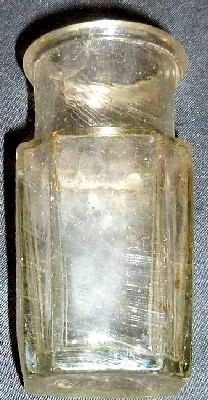
Flint Glass Medicine Bottle
to windows to the lowly bottles and simple containers. Two different kinds of glass were produced: white (or clear) glass and green glass.1
Clear glass or crystal, often referred to as flint glass during this period, was the more expensive. It was used in "apothecaries and chymist glass phyials, retorts &c. ...[It was made in] London, Bristol, Sturbridge, Nottingham, Sheffield New-Castle"2.
In the mid 1670s, London-based glass-maker George Ravenscroft started making a clear glass by mixing lead oxide and potash into a silica batch. "The flint glass that resulted was acclaimed almost immediately for its beauty and clarity."3 Ravenscroft perfected the mixture, and was creating reliably clear, leaded glass by the 1680s. As a result, "other British glass makers began to produce flint glass to which they also added increasing quantities of lead oxide, which became known as lead flint... leading to the development of the best apothecary glass containers."4
English flint glass tended to be heavier, more stable, and more refractive than the unleaded “soda” glass ...Flint glass is easily distinguished from soda glass. Besides being heavier in weight, it is also more resonant. It rings beautifully when tapped lightly with a fork, while soda glass gives off a dull thud. Leaded glass also is distinguishable by a faint grayish tinge. Both flint glass and high-quality German and Venetian soda glass sought to imitate the appearance of rock crystal, which is why we now use the word “crystal” for fine glassware.5
Of course, the leaded bottles were more expensive than the alternative 'green glass'. Green glass was created using coarse, less pure soda or potash as its principal alkaline base, resulting in a tint. Green glass bottles ranged in color from green to amber, the tint being caused by
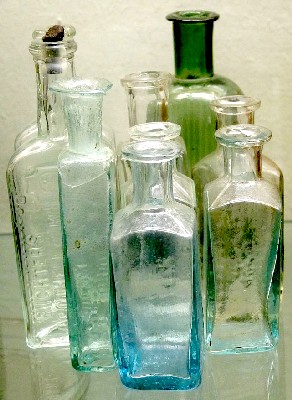
Photo: Wolfgang Sauber
Various 18th Century Glass Medicine Bottles
the presence of iron or aluminum in the raw materials. Other colors of glass could be intentionally created; cobalt could be added to produce a blue glass, magnesium oxide to generate a purple or 'black' glass and copper to create a red glass.6
Medicine bottles were first made from the less expensive green glass, eventually being produced using the more expensive flint glass in the 18th century, with "the two types coexisting until superseded by the wholly mould-blown medicine bottles of the mid-nineteenth century."7
An example of this coexistence of types of glass is suggested in the purchases made in 1725 for the opening of the apothecary at Guy's Hospital in London. Two hundred glass containers were bought which "included 'green rounds [round bottles],' 'flint rounds with stoppers,' 'flint squares [square bottles] with stoppers,' 'glass bottles for syrups and oils,' and 'widemouth pints for salts.'”8 Another source adds that "the economy-minded Guy's Hospital was buying special flint pill and extract glasses etc in 1725."9
Medical instrument historian Elizabeth Bennion says that of the few seventeenth century single dose medicine vials she found when researching her book, they were "dark green, of slightly ‘bubbly’ glass, and are either hexagonal or bulbous in shape. By the eighteenth century, either the same dark green or a soft blue-green glass was used."10 Note that Bennion is talking about single dose medicine bottles for individual patients, which probably would have been made as cheaply as possible. This may explain the darker coloring.
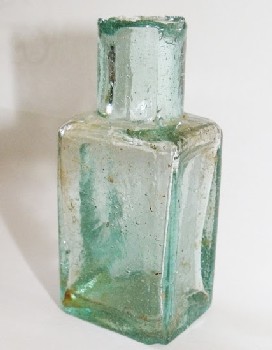
Pale Green Glass Bottle (With A Broken Lip)
The Museum of London website lists 441 'Phials and short-necked bottles', including several bottle fragments. While they don't date the bottles very precisely (probably because this is nearly impossible to do), among the bottles with dates that could be from the golden age of piracy, there are 20 square bottles. Their descriptions include 7 square bottles of pale green glass, 3 of pale natural green glass, 2 of natural green glass, 2 of blue-green glass, 2 of pale blue-green glass, 1 of brown-green glass, 1 of very pale green glass, 1 of clear glass (tending towards amber in the image) and 1 of an unspecified color. This is a fairly small sample and these would be land-based containers. Only a few of them are specifically noted as being used for medical purposes. However, the tendency here is clearly towards the various colors of green glass (90%), with the majority being pale green tints (65%).
Expense would be a concern for a sea-going medicine chest; merchant ships would necessarily try to make the costs of a voyage as cheap as possible to maximize profits. (Pirates would often take a captive merchant ship's medicine chest which would probably be their primary source of medicines.) That being said, the bottles would still have had to last at least as long as the voyage the ship was making and so they would likely have been made of good quality glass. Although it cannot be stated with certainty whether the bottles used on any given were flint or green glass, better quality green glass seems the most likely candidate. The excavation of a c. 1700 wreck of a merchantman off the island of Jutholmen near Stockholm, Sweden produced six light green square pharmaceurical bottles11, giving some credence to this idea.
1 This is an extreme oversimplification of the glass industry as it relates to England at this time. For more detailed information, see R.J. Charleston, English Glass and the Glass Used in England, c. 400-1940, 1984, pp. 42-108; 2 Daniel Defoe, The Complete English Tradesman, Vol. 2, 1727, p. 63; 3 Julius Kaplan, "A Short History of Eighteenth-Century English Glass", www.cosmosclub.org, gathered 8/30/15; 4 George Griffenhagen and Mary Bogard, History of Drug Containers and Their Labels, 1999, p. 13; 3 Kaplan, gathered 8/30/15; 6 Griffenhagen and Bogard, p. 12; 7 Charleston, p. 92; 8 Griffenhagen and Bogard, p. 13; 9 J.K. Crellin and J.R. Scott, Glass and British Pharmacy 1600-1900, F.N.L. Poynter, Editor, Wellcome Institute of the History of Medicine, London, 1972, p. 1; 10 Elizabeth Bennion, Antique Medical Instruments, p. 254; "Phials and small, short-necked bottles", http://archive.museumoflondon.org.uk, gathered 8/29/15; 11 Catharina Ingelman-Sundberg, "Preliminary report on finds from the Jutholmen wreck," The International Journal of Nautical Archeology and Underwater Exploration, 1976, 5.1, p. 57
Glass Containers - Shape
The golden age of piracy era information we have suggests that medicines chests preferred a square, double-glass bottle;
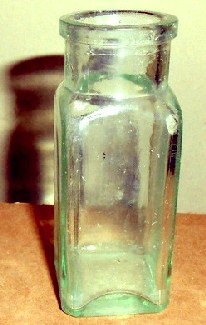
Square Green Glass Medicine Bottle
both military surgeon William Fabry (writing for sea and land surgeons)1 and sea surgeon John Moyle2 specify this style. Our other two sea surgeon authors - John Atkins and John Woodall - simply mention the use of glass containers without providing information about their preferred shape or design.
Apothecary bottles fell into two broad classes - an ornate style of many varied designs which was put on display in the pharmacist's shop and a utilitarian bottle which was either used to store medicines in the pharmacy or, in smaller forms, to dispense medicines to customers. The utilitarian bottles were "variously identified as 'rounds' or 'squares,' and later as 'furniture bottles'"3. We have already seen this terminology in the description of the bottles sold to Guy's Hospital in 1725 in the previous section.
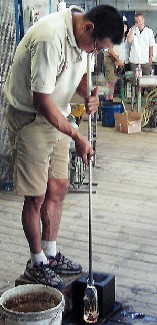
Photo: Per Meistrup
Making Square Glass Bottle
With Open Wood Mold
Bottles during this period were hand blown. Square glass bottles were made using an open-top dip mold - a mold formed in the shape of the base of the container to be made. During the golden age of piracy, dip molds would likely have been made of wood. (You can see the dark brown wooden square mold behind the bottle being blown in the image at left.)
These molds would usually have a slight taper, being wider at the top than the bottom to make it easier to remove the formed glass bottle from the mold. While glass is being blown, the wood of the dip mold is kept wet to help protect it from being destroyed by the molten glass. "This allowed steam to form in between the hot glass and mold surface causing the glass to "ride" on the steam cushion making the evidence of molding often very difficult to distinguish from free-blown bottles."4 Like free-blown bottles (those blown by hand without molds), dip molded bottles have no seam in the glass because of the simple design of single piece molds.
These bottles would also have had a lip on the top which was made "for tying a piece of skin or parchment over the opening to protect the contents."5 Multiple references are made to tying down the lids of medicine bottles during this period as we shall see in the discussion on container closures. A lip was almost certainly a feature of the bottles found in a sea surgeon's medicine chest.
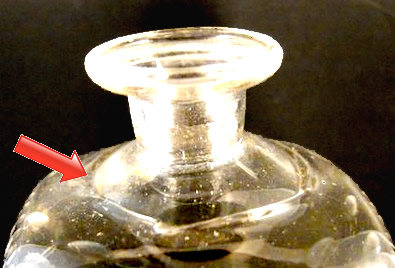
Double Bottle Dipping Line
One of the more interesting features of the bottles suggested by Fabry and Moyle is the idea of their being 'double-glass.' A double glass container is created using the half-post method, a variation of the procedure used for a standard dip mold bottle. The molten glass on the end of the blowpipe "is slightly expanded then dipped again into the glass pot to apply a second layer of glass over the initial gather [molten glass]."6 This second layer usually covers the body of the bottle, "which is typically indicated by a thickened ridge on the upper shoulder of the finished bottle."7
"Postes was a French term for a gather [glob] of molten glass. Thus the term 'half-post' for this method, though these bottles are well more that 'half' covered by the second coating of glass (McKearin & Wilson 1978)."8
Double bottles were created to protect medicines used on land as well. One of the medicine bottles shown by 18th century French instructor Pierre Dionis in his surgery instructional A course of chirurgical operations: demonstrated in the royal garden at Paris shows a double line of the half post method near the taper up of the neck of the bottle for styptic water. (It can be seen on the previous page here.)
1 Guiliem. Fabritius Hildanus aka. William Fabry. Cista Militaris, Or, A Military Chest, Furnished Either for Sea or Land, 1674, p. 10; 2 John Moyle, The Sea Chirurgeon, 1693, p. 41; 3 George Griffenhagen and Mary Bogard, History of Drug Containers and Their Labels, 1999, p. 13; 4 Bill Lindsey, "Dip Mold Bases", Society for Historical Archeology, sha.org, gathered 9/8/15; 5 Griffenhagen and Bogard, p. 12; 6 Bill Lindsey, "Glassmaking and Glassmakers: Half-post method", sha.org, gathered 8/30/15; 7 Bill Lindsey, "Bottle Glossary: German half-post", sha.org, gathered 8/30/15; 8 Lindsey, "Glassmaking and Glassmakers: Half-post method", gathered 8/30/15
Glass Containers - Sizes
A variety of bottle sizes would have been used to contain medicines for use at sea. The bottle sizes would be dependant on the amount of medicine the sea surgeon believed he would require for the voyage.
John Moyle talks about the quantities of medicine he felt were needed for ships. He first explains what "was used to carry in Men of War, and which have been approved of as sufficient at the View."1 He explains this using the British Royal Navy ship rating system where (during this period in history) a second rate ship would have 650-750 men and a 4th rate would have 185-365 men. It is unlikely that many merchant ships or even pirate ships would have this many men aboard a single ship.
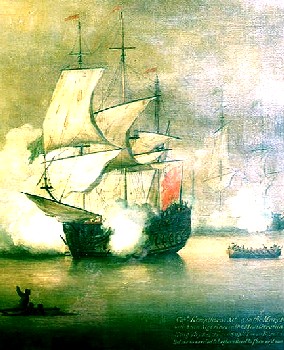
Artist: Peter Monomy
HMS Kingfisher - A Fourth Rate, 46 Gun Ship
When I have gone in a Second Rate, I commonly put up {3 pounds} a piece of them Electuaries, Syrups, and Cordial Waters that are given by greater quantities in the dose, and [are] most frequently used and expended at Sea, and the like in Oyls, Unguents and Emplasters, and have regulated the quantities of the rest of my Medicines accordingly ...taking extraordinary of them things that I expected would be most used there...
Now if you go in a Fourth Rate, you will not seem to need so great quantities as the Second, because you have a less Compliment of Men, and indeed it were so, (provided the length of the Voyage or Expedition were the same).
But for my part I have usually taken as large quantities of (except Astringent, and first Intentions [the first medicines needed when dressing wounds] for Wounds) Medicines in a Fourth Rate, as in a Second; because generally the length of the Fourth Rate Voyage (altho’ lesser Complement of Men) equalizeth the Second Rates, shorter Voyage, and greater compliment of Men...2
For merchant ships, Moyle first suggests finding out how much medicine was taken on previous voyages.3 He advises, "when I went to the Streights or West-Indies, in Merchant Men, I used to take {1-1/2 pound} of each of the Electuaries Syrups, Waters, Oyls, Unguents, and Plasters, that are commonly most expended at Sea, and less of other things, according to the foregoing Directions; and this I have found sufficient. Indeed them that are bound to the East-Indies, and other long Voyages, carry greater quantities, because of the length of the Voyage and sickly Climates they go into"4.
An earlier version of Moyle's book gives a more specific recommendation. Here, he says "for my own part when I have gone in a Ship of about 40 men, and a Voyage supposed 12 or 14 Months, I have carried of Medicines of the largest Dose, and most frequent use, {2 pounds or pints} of each, and of the rest proportionably."5 One wonders why he revised the amounts down and removed the details about the number of men aboard and the months voyaged in the later edition of his book.
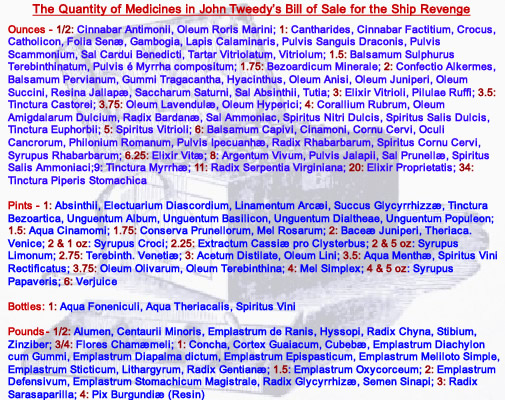
John Tweedy's Medicine Quantities for the Privateer The only list of sea-surgeon's medicine that actually provides individual medicine quantities is found in apothecary John Tweedy’s "Bill of Medicines" created for surgeon Nicholas Holmes of the Privateer Sloop Revenge in 1743.6
While John Moyle frequently suggests that he takes quantities of entire classes of medicine by the pound, Tweedy's bill of sale suggests that most of the medicines would have been measured in ounces and pints. Keep in mind that this list only tells the reader how much medicine was taken, not the size of the bottles it was taken in. We can infer that the bottles would be larger than the quantities of medicine, of course.
Most of the more exotic and expensive medicines would likely be represented only in small quantities (and thus in small bottles); the overall cost of a voyage was an important factor to its success, especially on a merchant ship.
Medicines used most frequently would either require larger bottles or multiple smaller bottles placed in multiple locations in the chest. As explained on the previous page, sea surgeon John Woodall appears to use multiple sizes of bottles (based on the size of the spaces in his chart of medicine locations in the medicine chest) as well as packing several bottles of the same medicines.
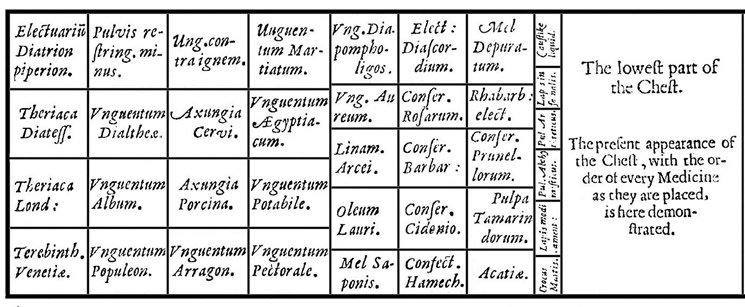 A Close Up of the Lower Left Part of the Woodall's Medicine Chest Showing the Different Size Spaces For Medicines |
This still begs the question, what were the standard sizes of medicine bottles? It must be kept in mind that standards would likely have been less uniform for bottle manufacture since multiple shops in multiple countries would be producing medicine bottles for sale.
German glass manufacturers established in the sixteenth century in Bohemia and Silesia manufactured medicine bottles which varied in capacity from four ounces to one gallon, "although most ranged from eight to sixteen ounces."7 Apothecary Thomas Baskerville's Exeter shop is recorded
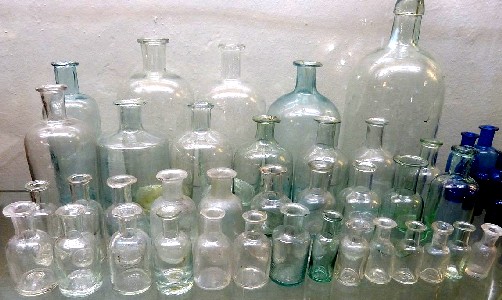
Photo: Wolfgang Sauber
A Variety of Different Sized Round Medicine Bottles - Heimathaus Ulrichsberg
as having "many gallon, pottle [half-gallon] and quart glasses" for his medicines in 15918.
John Moyle does provide some insight into smaller bottle sizes while explaining how to organize the drug chest.
"And in the partitions of your top Drawers you may place in some four, in others more, of your small square Glasses and Jars; as four ounces, two ounces, and [single] ounces"9.
Gathering all this disparate information together, standard medicine bottles would appear to include the following sizes: one, two, four, eight and sixteen ounce bottles. In addition there would have been quart (32 ounce), pottle (half gallon) and gallon containers. In his comments on medicine needed, Moyle discusses taking one and half, two and three pounds of medicines with him. When dealing with liquids, one pound of liquid is generally equivalent to a pint, so Moyle would need a two pint [or gallon] bottle for the one and a half and two pound liquid quantities and either a two gallon bottle or multiple containers for three pounds of liquid medicines.10
1 John Moyle, The Sea Chirurgeon, 1693, p. 37; 2 Moyle, p. 37-8; 3 Moyle, p. 36; 4 Moyle, p. 39; 5 John Moyle, Abstractum Chirurgæ Marinæ, 1686, p. 10; 6 Gathered from "158. John Tweedy’s Bill for Medicines. November 8, 1743". Privateering and Piracy in the Colonial Period Illustrative Documents, John Franklin Jameson, ed.,1923, p. 457-61; 7 George Griffenhagen and Mary Bogard, History of Drug Containers and Their Labels, American Institute of the History of Pharmacy, Madison, WI, 1999, p. 12; 8 J.K. Crellin and J.R. Scott, Glass and British Pharmacy 1600-1900, F.N.L. Poynter, Editor, 1972, p. 1; 9 Moyle, Abstractum, p. 17; 10 Thanks to Quartermaster James who pointed out that "A pint's a pound the world around" to me.

